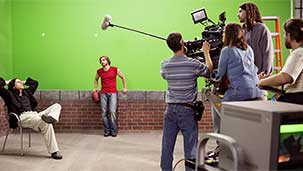How do you recreate the sound of a footstep, or the crash of glass breaking, in a way that heightens its effect without being cartoonish? The job of a foley artist is just that: to fill the sonic background of a film with everyday noises that don’t draw attention to the fact that they are created in a studio, rather than naturally occurring.
It’s similar to the challenge brothers James and Dave Franco face in trying to tell the story of Tommy Wiseau and his baffling masterpiece/garbage-fire of a film, The Room. Do you just play it straight, no frills? Or do you make choices that heighten the effect, and lean into the artifice?
Somehow The Disaster Artist succeeds in doing both.
The film works partly because it doesn’t do the same things that make The Room so improbably compelling. Much of what made that film impossible to turn away from was its complete ignorance of film grammar and apparent disinterest in the basics of storytelling.
Contrariwise, The Disaster Artist is quietly competent. The film is sharply edited, well written, and the performances are uniformly great—but, again, rarely showy or overt. Tommy Wiseau would be easy to parody, yet James Franco makes him genuine, and, in some odd way, tragic. There must have been a strong compulsion to MSTK the whole thing and go really broad. Instead they made the more difficult choice.
This is the strength of the film. The Room may be worthy of all the bemused scorn it has received over the past decade or so, but that isn’t what the makers of The Disaster Artist find interesting; what is human and universal about Wiseau’s ambitions and dreams is what they focus on. That Franco decides to spend time with that, instead of just an arch remake, is why The Disaster Artist works as well as it does.
In an inspired bit of casting James Franco’s brother Dave plays Sestero. Their scenes together are funny, uncomfortable, absurd, and even emotionally compelling.
Which is also a good way to describe the entire tone of the film.
The brothers’ interaction is the core of the film, and while it may come as a surprise to some, both are effective in shaping characters that feel grounded in reality, even as their shared project becomes increasingly outlandish. There are certainly moments that rely heavily on how unintentionally hilarious The Room is, but they support the characters rather than the comedy beats. What makes The Disaster Artist worth the effort is how effective it is in portraying a universal story about blind, naive ambition and its unintended consequences.
In the same way that a good foley artist chooses the correct moment to amp things up or pull them back, James Franco knows when to go big or go quiet. The resulting film portrays something surreal and outre in a way that never feels mocking. Instead, The Disaster Artist creates a subtle portrait of someone unique who, however imperfectly, realizes his life’s dream.
Sincerely,

Tim







